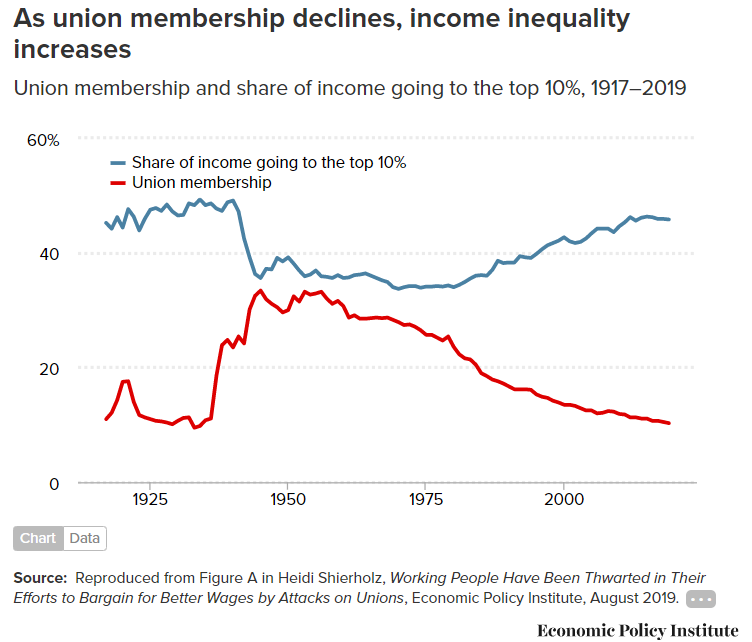This morning BLS released 2020 data on unionization, and it is fascinating. A thread. 1/ https://www.bls.gov/news.release/union2.nr0.htm
In 2020, 15.9 million workers in the U.S. were represented by a union—a decline of 444,000 from 2019. However, there was an *increase* in the unionization *rate* in 2020, from 11.6% to 12.1%. WHAT. 2/
In a nutshell, union workers saw less job loss than non-union workers in the pandemic. 3/
This was due to two key reasons. One is that unionized workers have had a voice in how their employers have navigated the pandemic, and have used this voice for things like negotiating for terms of furloughs or work-share arrangements to save jobs. 4/
The other reason is a “pandemic composition effect.” There has been (on average) more pandemic job losses in industries with lower unionization rates, like leisure and hospitality, and less job loss in sectors with higher unionization rates, like the public sector. 5/
A simple decomposition of the increase in the overall unionization rate in 2020 reveals that about half—47%—of the increase was the result of a pandemic composition effect, while half—53%—was due to union workers seeing less job loss than nonunion workers in the same industry. 6/
The number of unionized state & local government workers actually rose (by 91,000) in 2020—even though state and local government employment declined by 485,000. This was likely due in part to the effort by state & local govt unions to increase membership in the wake of Janus. 7/
Women experienced more job loss than men in 2020 (a loss of 4.9 million jobs for women compared to 4.6 million for men), but the number of women in unions declined less (there was a decline in unionization of 31,000 among women and 413,000 among men). 8/
This was likely due largely to composition effects—e.g. women being disproportionately concentrated in leisure & hospitality, which has seen a lot of job loss but has low unionization rates, & in the public sector, which has seen less job loss & has higher unionization rates. 9/
Unionization rates for women (11.8%) inched close to rates for men (12.3%). 10/
Of all major racial and ethnic groups, Black workers have the highest unionization rates, at 13.9%. This compares with 12.0% for white workers, 11.0% for Latinx workers, and 10.0% for AAPI workers. 11/
In 2020, Black workers experienced the largest rate of decline in employment (-8.3%, compared with, for example, -6.4% for white workers) but Black workers also experienced the largest increase in the rate of unionization. 12/
The fact that Black workers saw an increase in unionization is likely due largely to composition effects. Black workers are more concentrated in the public sector, which has seen less job loss & has higher unionization rates. This is particularly true for Black women. 13/
One of the main pillars of Biden’s Build Back Better plan is to dismantle the barriers to union organizing and collective bargaining. Today’s data reinforce the importance of this goal. AT 12.1%, the unionization rate is still less than half what it was roughly 40 years ago. 14/
Unions help narrow the black–white wage gap. This means that the decline of unionization has played a significant role in the expansion of the Black–white wage gap over the last 4 decades—and that an increase in unionization would move us towards racial economic justice. 15/
Importantly, the decline in unionization over the last four decades occurred despite a considerable increase in the share of workers who say they want union representation. 16/
Why the disconnect? U.S. employers go to extraordinary lengths to keep workers from forming unions. Employers are charged with violating labor law in 41.5% of union election campaigns. In 1 in 5 campaigns, employers are charged with illegally firing workers for organizing. 17/
Employers are charged with making threats, engaging in surveillance activities, or harassing workers in nearly a third of all union election campaigns. And, employers spend roughly $340 million annually on “union avoidance” consultants to help them stave off union elections. 18/
The key reasons workers want to be in unions—to improve their wages, benefits, and working conditions—are precisely the reasons unions are opposed so fiercely by corporate interests. 19/
As union membership has eroded, the share of total income in the economy going to the rich has skyrocketed. In other words, efforts to erode unionization have paid off handsomely for the small sliver of people on the winning end of rising inequality. 20/
The huge gap between the share of workers who *want* a union and the share of workers who are *in* a union underscores that our system of labor laws is not working. Fundamental reform is required to restore workers’ rights to a union and collective bargaining. 21/
The Protecting the Right to Organize (PRO) Act, which passed the House last year with bipartisan support, provides a comprehensive set of reforms that would strengthen private-sector workers’ right to form a union and engage in collective bargaining. The time is now. 22/
We ( @cmmcnich, Margaret Poydock, and I) have a new quick paper on the 2020 unionization numbers that covers what’s in this thread and a little more depth about what they mean. Here you go. n/ https://www.epi.org/publication/union-workers-had-more-job-security-during-the-pandemic-but-unionization-remains-historically-low-data-on-union-representation-in-2020-reinforce-the-need-for-dismantling-barriers-to-union-organizing/
Addendum: I think union representation is a more-relevant statistic than union membership when considering the economic impact of unions, because all workers in a bargaining unit—regardless of whether they are union members—get the benefit of being represented by the union.
So, throughout this thread, when I say “unionization,” I’m talking about people represented by a union (not just those who are members of a union). But the main results are the same if you look at union membership instead of union representation.

 Read on Twitter
Read on Twitter


